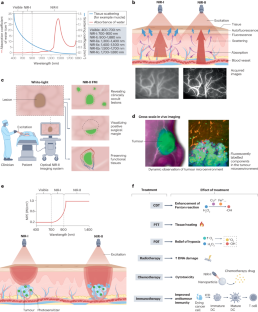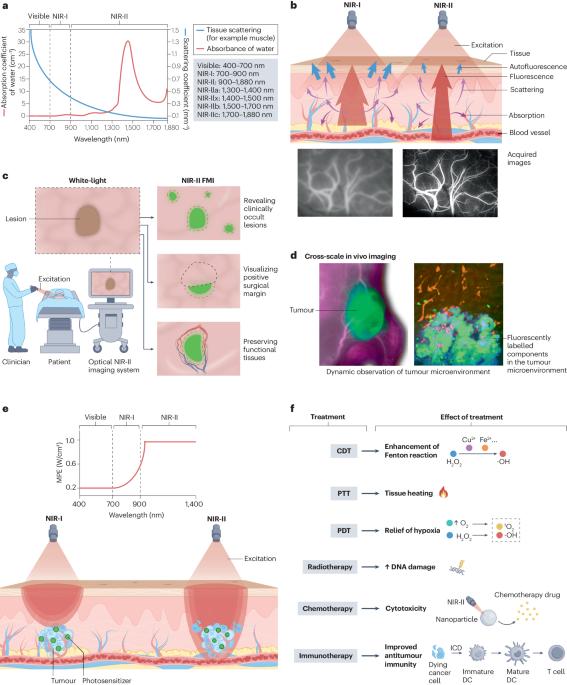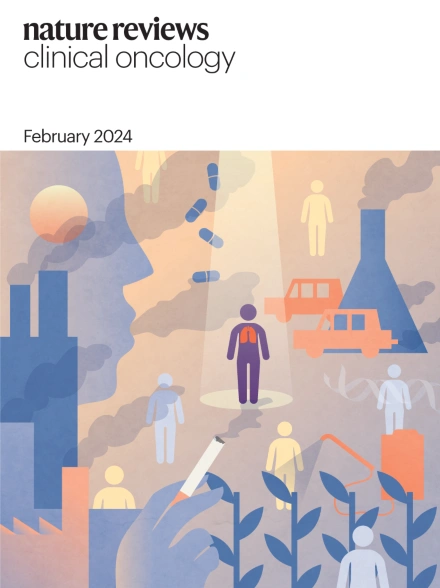NIR-II light in clinical oncology: opportunities and challenges
IF 81.1
1区 医学
Q1 ONCOLOGY
引用次数: 0
Abstract
Novel strategies utilizing light in the second near-infrared region (NIR-II; 900–1,880 nm wavelengths) offer the potential to visualize and treat solid tumours with enhanced precision. Over the past few decades, numerous techniques leveraging NIR-II light have been developed with the aim of precisely eliminating tumours while maximally preserving organ function. During cancer surgery, NIR-II optical imaging enables the visualization of clinically occult lesions and surrounding vital structures with increased sensitivity and resolution, thereby enhancing surgical quality and improving patient prognosis. Furthermore, the use of NIR-II light promises to improve cancer phototherapy by enabling the selective delivery of increased therapeutic energy to tissues at greater depths. Initial clinical studies of NIR-II-based imaging and phototherapy have indicated impressive potential to decrease cancer recurrence, reduce complications and prolong survival. Despite the encouraging results achieved, clinical translation of innovative NIR-II techniques remains challenging and inefficient; multidisciplinary cooperation is necessary to bridge the gap between preclinical research and clinical practice, and thus accelerate the translation of technical advances into clinical benefits. In this Review, we summarize the available clinical data on NIR-II-based imaging and phototherapy, demonstrating the feasibility and utility of integrating these technologies into the treatment of cancer. We also introduce emerging NIR-II-based approaches with substantial potential to further enhance patient outcomes, while also highlighting the challenges associated with imminent clinical studies of these modalities. Expansion of the utilizable spectrum of light from the visible region to the near-infrared (NIR) window has greatly facilitated the clinical application of optical technologies for cancer imaging and phototherapy. However, use of light in the first NIR region (NIR-I) has important limitations, some of which might be overcome with emerging technologies utilizing NIR-II light. In this Review, the authors describe the current clinical experience with NIR-II-based cancer imaging and phototherapy, and discuss emerging NIR-II-based approaches that might further enhance patient outcomes. They also highlight challenges that will need to be addressed to translate NIR-II-based modalities from bench to bedside.


临床肿瘤学中的近红外-II 光:机遇与挑战
利用第二段近红外波段(NIR-II;900-1,880 nm 波长)光的新策略为更精确地观察和治疗实体瘤提供了可能。过去几十年来,利用近红外-II 光开发了许多技术,目的是在最大限度地保留器官功能的同时精确地消除肿瘤。在癌症手术过程中,近红外-II 光学成像技术能以更高的灵敏度和分辨率显示临床上隐匿的病灶和周围重要结构,从而提高手术质量,改善患者预后。此外,使用近红外-II 光还能选择性地向更深层的组织输送更多的治疗能量,从而有望改善癌症光疗。基于近红外 II 光的成像和光疗的初步临床研究表明,其在降低癌症复发率、减少并发症和延长生存期方面的潜力令人印象深刻。尽管取得了令人鼓舞的成果,但创新近红外-II 技术的临床转化仍面临挑战且效率低下;有必要开展多学科合作,弥合临床前研究与临床实践之间的差距,从而加快将技术进步转化为临床效益。在本综述中,我们总结了基于近红外-II 技术的成像和光疗的现有临床数据,证明了将这些技术整合到癌症治疗中的可行性和实用性。我们还介绍了基于近红外-II 的新兴方法,这些方法具有进一步提高患者疗效的巨大潜力,同时也强调了与这些方法即将开展的临床研究相关的挑战。
本文章由计算机程序翻译,如有差异,请以英文原文为准。
求助全文
约1分钟内获得全文
求助全文
来源期刊
CiteScore
99.40
自引率
0.40%
发文量
114
审稿时长
6-12 weeks
期刊介绍:
Nature Reviews publishes clinical content authored by internationally renowned clinical academics and researchers, catering to readers in the medical sciences at postgraduate levels and beyond. Although targeted at practicing doctors, researchers, and academics within specific specialties, the aim is to ensure accessibility for readers across various medical disciplines. The journal features in-depth Reviews offering authoritative and current information, contextualizing topics within the history and development of a field. Perspectives, News & Views articles, and the Research Highlights section provide topical discussions, opinions, and filtered primary research from diverse medical journals.

 求助内容:
求助内容: 应助结果提醒方式:
应助结果提醒方式:


